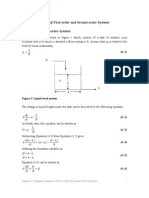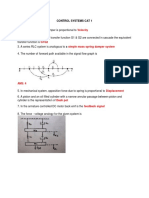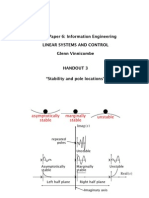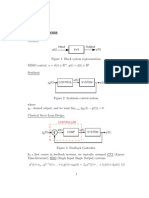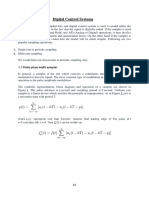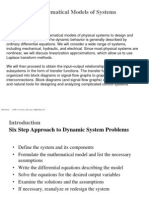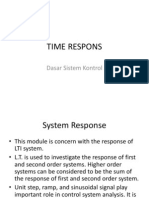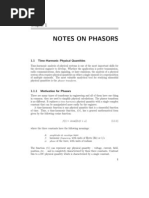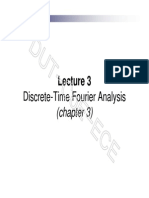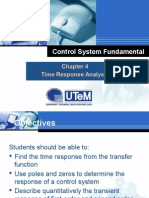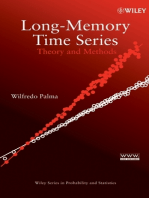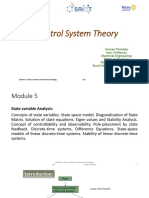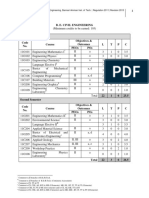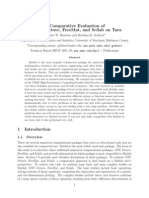Frequency-Domain Analysis of Dynamic Systems
Uploaded by
moomeejeeFrequency-Domain Analysis of Dynamic Systems
Uploaded by
moomeejeeME 413 Systems Dynamics & Control
Chapter 9: Frequency Domain Analyis of Dynamic Systems Systems
Chapter9:
FrequencyDomainAnalysisof
DynamicSystems
A.Bazoune
9.1 INTRODUCTION
The term Frequency Response refers to the steady state response of a system to a sinusoidal
input.
An input f ( t ) is periodic with a period if f ( t + ) = f ( t ) for all values of time t ,
where is a constant called the period. Periodic inputs are commonly found in many
applications. The most common perhaps is ac voltage, which is sinusoidal. For the common
ac frequency of 60 Hz, the period is =
1
s . Rotating unbalanced machinery produces
60
periodic forces on the supporting structures, internal combustion engines produce a periodic
torque, and reciprocating pumps produce hydraulic and pneumatic pressures that are
periodic.
Frequency response analysis focuses on sinusoidal inputs. A sine function has the
form A sin t , where A is the amplitude and is its frequency in radians/seconds. Notice
that a cosine is simply a sine shifted by 90o or 2 rad, as cos t = sin t +
9.2 SINUSOIDAL TRANSFER FUNCTION (STF)
When a sinusoidal input is applied to a LTI system, the system will tend to vibrate at its own
natural frequency, as well as follow the frequency of the input. In the presence of damping, that
portion of motion sustained by the sinusoidal input will gradually die out. As a result, the
response at steady-state is sinusoidal at the same frequency as the input. The steady-state
output differs from the input only in the amplitude and the phase angle. See Figure 9-1 below.
X sin ( t + )
A sin4
3t
142
Inpu t
14442444
3
Output
Figure 9-1.
1/27
ME 413 Systems Dynamics & Control
Chapter 9: Frequency Domain Analyis of Dynamic Systems Systems
Thus, the output-input amplitude ratio and the phase angle between the output and input
sinusoids are the only parameters needed to predict the steady state output of LTI systems
when the input is a sinusoid.
X
: output-input amplitude ratio
A
: phase angle between output and input
Forced Vibration without damping
Figure 9-2 illustrates a spring-
mass system in which the mass is subjected to a
sinusoidal input force p (t ) = Po sin t . Let us find the
response of the system when it is initially at rest. The
equation of motion is
m &&
x + k x = Po sin t
where
is the output,
p(t ) = Po sin t
P is the amplitude of the
excitation and is the forcing (excitation) frequency.
x
Figure 9-2
Spring-mass system.
The above equation can be written in the form
&&
x+
where
k
P
x = o sin t
m
m
(9-1)
k m = n is known as the natural frequency of the system. The solution of Equation
(1) consists of the vibration at its natural frequency (the complementary solution) and that at
the forcing frequency (the particular solution) as shown in Figure 9-3. Thus,
x ( t ) = complementary solution + particular solution
Let us obtain the solution under the condition that the system is at rest. Take LT of both sides
of Equation (9-1) for zero initial conditions, i.e.,
x ( 0 ) = x& ( 0 ) = 0 .
Po
2 k
s + X (s) =
m
m s2 + 2
where
X ( s ) = L [ x(t ) ] . Substituting k m = n2
X (s) =
and Solving for
X (s)
yields
Po
1
2
2
2
m s + s + n2
The above equation can be written in partial fraction as:
X (s) =
Po
1
A s + B1 A2 s + B2
= 12
+ 2
2
2
2
2
m s + s + n s + 2
s + n2
2/27
ME 413 Systems Dynamics & Control
where
A1 , A2 , B1
Chapter 9: Frequency Domain Analyis of Dynamic Systems Systems
and
The expression for
B2 are left as an exercise for the student.
X ( s ) is therefore
X (s) =
Po
k m 2
1 n
Po
+
2
2
2 2
2
n s + n k m s +
The inverse Laplace Transform of the above equation is given by
[ x (t )] = L
-1
P ( n )
Po
sin nt +
sin t
X ( s ) = o
2
2
k
m
k
m
14243
1424
3
A
B
in
=
+ B
A sin nt
1
4s24
3t
1
424
3
Complementary Solution
where
A =
Po ( n ) Po ( n )
=
k m 2
Den
and
(9-2)
Particular Solution
B=
Po
P
= o
2
k m
Den
where Den = k m .
2
P
lim B = o static deflection
k
0
2
As increases from zero the denominator Den = k m becomes small and the
amplitude increases, therefore, both A and B increase.
The expression of the denominator Den can be written as
2
k
2
2
2
2
2
Den = k m = m = m n = m n 1 2
m
As
0,
lim A = 0
0
It is clear that when
and
= n
the denominator becomes zero and the amplitude of
vibrations increases without bound, therefore resonance occurs.
Sinusoidal Transfer Function (STF)
(STF) is defined as the transfer function
( j).
G (s )
G (s )
Figure 9-3
in which the variable
s = j
1442443
TF
The sinusoidal Transfer Function
(s )
G ( j )
1442443
STF
Sinusoidal Transfer Function STF
3/27
is replaced by
ME 413 Systems Dynamics & Control
Chapter 9: Frequency Domain Analyis of Dynamic Systems Systems
When only the steady-state solution (the particular solution) is wanted, the STF
G ( j)
can simplify the solution. In our discussion, we are concerned with the behavior of
stable, LTI system under steady state conditions, i.e., that is after the initial transients died
out. We shall see that sinusoidal inputs produce sinusoidal outputs in the steady state with
the amplitude and phase angle at each frequency determined by the magnitude and the
angle of G
( j ) , respectively.
Deriving Steady State Output caused by Sinusoidal Input
Figure 9-4 shows an LTI system for which the input
p (t ) = Po sin t
P (s )
and the output is
G (s )
P (s )
X (s ) .
X (s )
1 4 42 4 43
TF
Figure 9-4
The input
p (t )
Linear Time Invariant (LTI) System
is sinusoidal and is given by
p (t ) = Po sin t
We shall show that the output
x (t )
at steady state is given by
x (t ) = G ( j ) Po sin (t + )
where
G ( j)
and
are the magnitude and phase angle of G
Suppose that the transfer function G
in
( j ) , respectively.
( s ) can be written as a ratio of two polynomials
s ; that is
G (s ) =
The Laplace transform
where
s i
X (s )
P ( s ) = L [ p(t )] .
K ( s + z 1 )( s + z 2 )L( s + z n )
( s + s1 )( s + s 2 )L( s + s n )
is
X (s ) = G (s ) P (s )
(9-3)
Let us limit our discussion to stable systems. For such systems, the real parts of the
are negative. The steady state response of a stable linear system to a sinusoidal input
does not depend on I. Cs, so they can be ignored.
4/27
ME 413 Systems Dynamics & Control
Chapter 9: Frequency Domain Analyis of Dynamic Systems Systems
( s ) has only distinct poles, then the partial fraction of Equation (9-3) yields
If G
P
s 2 + 2
a
a
b
b
b
=
+
+ 1 + 2 +L+ n
s + j s j s + s1 s + s 2
s + sn
X (s ) = G (s )
where
response
and
bi ( i = 1,2,L, n )
x (t )
are constants and
(9-4)
is the complex conjugate of
a . The
can be obtained by taking the inverse Laplace transform of Equation (9-4)
[ x (t )] = L
-1
X ( s ) = ae j t + a e j t + b1 e s1 t + b 2 e 2 + L + b n e n
144444244444
3
s t
s t
For a stable system these terms 0 as t
since they have negative real part
If
G (s )
t he
s j t
involves
(where
multiple poles
sj ,
then
x (t )
will involve such terms as
h = 0,1, 2,L, k 1). Since the real part of the s j is negative for a
stable system, the terms
t he
s j t
when
t .
Regardless of whether the system involves multiple poles, the steady state response becomes
x (t ) = ae j t + a e j t
where the constants
Notice that
and
(9-5)
can be evaluated from Equation (9-4):
a = G (s )
P
P
s + j)
= G ( j )
2 (
s +
2j
s = j
a = G (s )
P
P
s
j
G ( j)
=
(
)
s 2 + 2
2j
s = j
is the complex conjugate of
a . Referring to Figure 9-5, we can write
( j )
G ( j)
Gy
Gx
G( j)
Figure 9-5
Complex function and its complex conjugate.
5/27
ME 413 Systems Dynamics & Control
Chapter 9: Frequency Domain Analyis of Dynamic Systems Systems
G ( j ) = Gx +G y
= G ( j ) cos + j G ( j ) sin
= G ( j ) ( cos + j sin )
= G ( j ) e j
Notice that
G ( j ) = e j = . Similarly,
G ( j ) = G ( j ) e j = G ( j ) e j
Substitute the expressions of
G ( j)
and
G ( j )
into the expressions of
and
a , one
can get
P
G ( j ) e j
2j
P
a=
G ( j ) e j
2j
a=
Then Equation (9-5) can be written as
e ( )
x (t ) = G ( j ) Po
2j
1442443
e
j (t + )
j t +
sin (t + )
= G ( j ) Po sin (t + )
(9-6)
= X sin (t + )
where
X = G ( j ) Po and = G ( j )
Same frequency
p ( t ) = Po sin t
Input
G ( j )
x(t ) = X sin ( t + )
Output
X = P G ( j )
= G ( j )
o
Output amplitude
Phase of the output
Figure 9-6
Input output relationships for sinusoidal inputs.
6/27
ME 413 Systems Dynamics & Control
Chapter 9: Frequency Domain Analyis of Dynamic Systems Systems
Therefore for sinusoidal inputs,
X ( j ) amplitude ratio of the output
=
P ( j ) sinusoid to the input sinusoid
G ( j) =
G ( j ) =
imaginary part of G ( j )
X ( j)
= tan 1
P ( j)
real part of G ( j )
phase shift of the output sinusoid
=
with respect to the input sinusoid
(9-8)
Example 9-1 (Textbook Page 437)
Consider the TF
X (s)
1
= G(s) =
P(s)
Ts + 1
p(t ) = Po sin t , what is the steady-state output x ( t ) .
For the sinusoidal input
(9-7)
Solution
Substituting
for
in
G (s)
yields
G ( j ) =
1
Tj + 1
The output-input amplitude ratio is
G ( j ) =
and the phase angle
1
T 2 +1
2
is
= G ( j ) = tan 1 T
So, for the input
p (t ) = Po sin t , the steady-state output x ( t ) can be found as
x(t ) =
Po
T +1
2
sin (t tan 1 T )
Example 9-2
Find the steady state response of the following system:
7/27
(9-9)
ME 413 Systems Dynamics & Control
Chapter 9: Frequency Domain Analyis of Dynamic Systems Systems
y& + 5 y = 4 p& + 12 p
if the input is
p (t ) = 20sin 4t
Solution
First obtain the TF
G (s ) =
From the input
p (t ) = 20sin 4t
Y ( s ) 4s + 12
s +3
=
=4
P (s )
s +5
s +5
, it is clear that
= 4 rad/s. Therefore, the sinusoidal
Transfer function is
G ( j) =
Y ( j)
j + 3
j4+3
3+ j 4
=4
=4
=4
5+ j4
G ( j)
j + 5
j4+5
Then
32 + ( 4 )
3+ j 4
25
G ( j) = 4
=4
=4
= 3.123
2
5+ j4
41
52 + ( 4 )
2
and
3 + j
= 4 + ( 3 + j ) ( 5 + j )
5 + j
4
4
= 0o + tan 1 tan 1 = 0o + tan 1 tan 1 = 0.253 rad
3
5
3
5
= G ( j ) = 4
The steady state response is
y (t ) = G ( j ) Po sin (t + )
= 3.123 20sin ( 4t + 0.253) = 62.46sin ( 4t + 0.253)
Example 9-3 (Example 9-2 in the Textbook
Page 437-438)
Suppose that a sinusoidal force
p (t ) = Po sin t
is applied to the mechanical system shown in Figure
9-7. Assuming that the displacement x is measured
from the equilibrium position, find the steady-state
output.
Solution
The equation of motion for the system is
m &&
x + bx& + k x = p(t )
Figure 9-7
8/27
Mechanical system
ME 413 Systems Dynamics & Control
Chapter 9: Frequency Domain Analyis of Dynamic Systems Systems
The Laplace Transform of this equation, assuming zero I.Cs, is
(m s
where
X ( s ) = L [ x(t ) ]
and
+ bs + k ) X ( s ) = P ( s )
P ( s ) = L [ p(t )] . (Notice that the I.Cs do not affect the
steady state output and so can be taken to be zero). The TF is
X (s)
1
= G (s) =
P( s)
( m s 2 + bs + k )
Since the input is a sinusoidal function
p (t ) = Po sin t , we can use the STF to obtain the
steady-state solution. The STF is
X ( j )
1
1
= G ( j ) =
=
2
P ( j )
m + bj + k ( k m 2 ) + jb
From Equation (9-6), the steady-state output
x ( t ) can be written as
x(t ) = G ( j ) Po sin (t + )
where
G ( j ) =
(k m )
2 2
+ b 2 2
and
= G ( j ) =
( k m ) + jb
2
= tan 1
b
k m 2
therefore
x (t ) =
(k m )
2
Since
n2 = k m
and
Po
2
+b
2
sin t tan
k m
b
b / k = 2 / n , the equation for x ( t ) can be written as
Po / k
1
k
sin t tan
x (t ) =
2
2
k m 2
k m 2 + b 2
2
k
k
k k
k
or
x (t ) =
Po / k
1 ( n )2 + ( 2 ( n ) )2
2
9/27
sin t tan
2 ( n )
1 ( n )
2
ME 413 Systems Dynamics & Control
Let
Chapter 9: Frequency Domain Analyis of Dynamic Systems Systems
= n frequency ratio , the above equation can be written as
x st
x (t ) =
1 + ( 2 )
2
where
xst = Po k
the amplitude ratio
x st
sin t tan
x ( t ) as X
is the static deflection. Writing the amplitude of
X / xst
and the phase shift
1 2 + ( 2 )
2
The variations of the amplitude ratio
and 9-9 as a function of
(9-10)
are
= tan 1
and
2
X / xst
and the phase shift
for different values of
, we find that
2
1
are shown in figures 9-8
Frequency Response Magnitude Ratio
15
= 0.0
0.05
X/xst
10
0.1
0.25
0.50
0
5.0
-5
0.2
0.4
1.00
2.0
0.6
0.8
1.2
1.4
1.6
1.8
= /n
Figure 9-8
Variation of the amplitude ratio
10/27
X / xst
with the frequency ratio
ME 413 Systems Dynamics & Control
Chapter 9: Frequency Domain Analyis of Dynamic Systems Systems
0.
05
Frequency Response Phase Angle
= 0.0
1
0.
0.25
1.00
0.50
2.0
()
5.0
/2
= 0.0
0.5
1.5
2.5
= / n
Figure 9-9
Variation of the phase
with the frequency ratio
9.3 VIBRATIONS IN ROTATING MECHANICAL SYSTEMS
Vibration due to Rotating Unbalance
Force inputs that excite vibratory motion
often arise from rotating unbalance, a
condition that arises when the mass center of
a rotating rigid body and the center of
rotation do not coincide.
Figure 9-10 shows an unbalanced machine
resting on shock mounts.
Total Mass M
Assume that the rotor is rotating at a constant
speed rad/s and that the unbalanced mass
m is located at a distance r from the center
of rotation. Then the unbalanced mass will
produce a centrifugal force
m 2r .
The equation of motion for the system is
M &&
x + bx& + k x = p(t )
(9-11)
Figure 9-10
where
p (t ) = m 2 r sin t
11/27
Unbalance machine resting on
shock mounts
ME 413 Systems Dynamics & Control
Chapter 9: Frequency Domain Analyis of Dynamic Systems Systems
Is the force applied to the system. Take LT of both sides of Equation. (9-11), assuming zero
I.Cs, we have
(M s
or
+ bs + k ) X ( s ) = P ( s )
X (s)
1
= G (s) =
P( s)
( M s 2 + bs + k )
The STF is
X ( j )
1
= G ( j ) =
P ( j )
( k M 2 ) + jb
For the sinusoidal forcing function
p (t ) , the steady-state output is obtained from Equation.
(9-6) as
x(t ) = X sin (t + )
b
= G ( j ) m 2 r sin t tan 1
2
kM
m 2r
b
sin t tan 1
2
2
kM
( k M 2 ) + b2 2
Divide the numerator and denominator of the amplitude and those of the phase angle by
and substitute
= k /M
2
n
b / M = 2n
and
into the result, the steady-state output
becomes
x(t ) =
m 2r / k
1 ( n )2 + ( 2 ( n ) )2
2 ( n )
sin t tan 1
2
(
)
n
or
x(t ) =
where
m 2r / k
1 2 + ( 2 )
2
2
sin t tan 1
1 2
= n .
9.4 VIBRATION ISOLATION
Vibration isolation is a process by which vibratory effects are minimized or eliminated. The
function of a vibration isolator is:
to reduce the magnitude of force transmitted from a machine to its foundation.
or to reduce the magnitude of motion transmitted from a vibratory foundation to a
machine.
12/27
ME 413 Systems Dynamics & Control
Chapter 9: Frequency Domain Analyis of Dynamic Systems Systems
Figure 9-11(a) illustrates the case in which the source of vibration is a vibrating force
originating within the machine (force excitation). The isolator reduces the force transmitted to
the foundation. In Figure 9-11(b) the source of vibration is a vibrating motion of the
foundation (motion excitation). The isolator reduces the vibration amplitude of the machine.
Figure 9-11
Vibration isolation. (a) Force excitation; (b) Motion excitation.
Isolation Systems
Passive: It consists of a resilient member (stiffness) and energy dissipater (damping)
that have constant properties. Examples are metal springs, cork, felt, pneumatic
springs, elastomer (rubber) springs.
Active: External power is required for the isolator to perform its function. An active
isolator is comprised of a servomechanism with a sensor, signal processor and an
actuator.
A typical vibration isolator is shown in Figure 9-12. (In a simple vibration isolator, a
single element like synthetic rubber can perform the functions of both the load-supporting
means and the energy-dissipating means).
Machine
Vibration
Isolator
Figure 9-12
13/27
Vibration isolator.
ME 413 Systems Dynamics & Control
Chapter 9: Frequency Domain Analyis of Dynamic Systems Systems
Practical Examples.
Figure 9-13
(a)- Undamped spring mount;(b)- Damped spring mount;(c)- Pneumatic rubber Mount.
Transmissibility.
Transmissibilty is a measure of the reduction of a
transmitted force or motion afforded by an isolator
Transmissibility for Force excitation.
For the system shown in
Figure 9-8, the source of vibration is a vibrating force resulting from the unbalance of the
machine. The transmissibility in this case is the force amplitude ratio and is given by
Transmissibility=TR =
Ft Amplitude of the transmitted force
=
F0
Amplitude of the excitatory force
Let us find the transmissibility of this system in terms of the damping ratio
frequency ratio
= n .
and the
The excitation force (in the vertical direction) is caused by the unbalanced mass of the
machine and is
p (t ) = m 2 r sin t = F0 sin t
The equation of motion for the system is equation (9-11), rewritten here for convenience:
M &&
x + bx& + k x = p(t )
where
is the total mass of the machine including the unbalance mass
(9-12)
m . The force f ( t )
transmitted to the foundation is the sum of the damper and spring forces, or
14/27
ME 413 Systems Dynamics & Control
Chapter 9: Frequency Domain Analyis of Dynamic Systems Systems
f (t ) = bx& + k x = Ft sin (t + )
(9-13)
Taking the LT of Equations. (9-12) and (9-13), assuming zero I. Cs, gives
(M s
+ bs + k ) X ( s ) = P ( s )
( bs + k ) X ( s ) = F ( s)
where
X ( s ) = L [ x(t ) ] , P ( s ) = L [ p(t ) ] and F ( s ) = L [ f (t )] . Hence,
X (s)
1
=
P ( s ) M s 2 + bs + k
F (s)
1
=
X ( s ) bs + k
Eliminating
X (s)
from the above two equations yields
F ( s ) F (s) X ( s )
bs + k
=
=
P ( s ) X ( s ) P ( s ) M s 2 + bs + k
The STF is thus
F ( j )
( b M ) j + ( k M )
bj + k
=
=
P ( j ) M 2 + bj + k 2 + ( b M ) j + ( k M )
Substituting
k M = n2
obtain
and
b M = 2n
into the last equation, and simplifying, we
1 + j ( 2 n )
F ( j )
=
P ( j ) 1 ( n )2 + j ( 2 n )
From which it follows that
F ( j)
P ( j )
where
1 + ( 2 n )
1 ( n ) + ( 2 n )
2
1 + ( 2 )
(1 ) + ( 2 )
2
= n . Noting that the amplitude of the excitatory force is F0 = P ( j )
that the amplitude of the transmitted force is
TR =
Ft
F0
F ( j)
P ( j )
and
Ft = F ( j ) , we obtain the transmissibility:
15/27
1 + ( 2 )
(1 ) + ( 2 )
2
(9-14)
2
ME 413 Systems Dynamics & Control
which depends on
as a function of
Chapter 9: Frequency Domain Analyis of Dynamic Systems Systems
and
TR
only. Figure 9-14 shows plots of
for different values of
. It immediately follows from Figure 9-14 that the condition > 2
must
be met in order that TR < 1 , which means the transmitted force amplitude is less than the
excitation force amplitude.
Curves of Transmissibility T
6
= 0.0
0.1
5
TR
3
0.25
2
0.50
1.0
1
2.0
0
Amplification Region
TR > 1
-1
0
0.2
0.4
0.6
0.8
Isolation Region
TR < 1
1.2
= / n
Figure 9-14
1.6
Curves of transmissibility TR versus
1.8
= n
Therefore, in order to achieve transmitted force reduction, often called suppression, it is
important to design the spring constant k such that n satisfies the condition that
= n > 2
or
n =
<
m
2
for a given mass
and a specified forcing
. When = 2 , however the Transmissibility is equal to unity regardless of
the value of .
frequency
= n . It is clear that:
TR = 1 and = 2 .
Figure 9-14 shows some curves of the transmissibility versus
all the curves pass through a critical point where
For <
decreases.
For
For
For
2,
as the damping ratio
increases, the transmissibility at resonance
> 2 , as increases, the transmissibility increases.
< 2 , or < 2 n , increasing damping improves the vibration isolation.
> 2 , or > 2 n , increasing damping adversely affects the vibration
isolation
16/27
ME 413 Systems Dynamics & Control
Notice that since
Chapter 9: Frequency Domain Analyis of Dynamic Systems Systems
P ( j ) = F0 = m 2 r , the amplitude of the force transmitted to the
foundation is
Ft = F ( j ) =
m 2 r 1 + ( 2 )
(1 ) + ( 2 )
2 2
(9-15)
2
Example 9-4
Suppose a machine is mounted on an elastic bearing, which in turns sits on a rigid foundation.
The bearing damping is negligible. In operation the machine generates a harmonic force
having a frequency of 1000 rpm. If the mass of the machine is 50 kg, find the condition on the
equivalent spring constant k of the elastic bearing for suppression of the transmitted force.
Also find the percentage of the dynamic force, generated by the machine, that is transmitted
into the foundation if the stiffness of the bearing is k = 200 kN/m .
Solution
The condition for suppression of the transmitted force is given by
n =
The forcing frequency is
values of
and
= n > 2
or
<
m
2
= 1000 rpm = (1000)(2 ) 60 = 104.7 rad s . Substituting the
into the above equation gives
k 104.7
<
= 74.05 rad s
m
2
n =
or
k < m ( 74.05 ) = ( 50 )( 74.05 ) = 274 kN/m
2
which is the desired condition on the stiffness of the bearing.
When the stiffness of the foundation is k = 200 kN/m , the natural frequency of the
machine-bearing system is given by
n =
k
200000
=
= 63.2 rad s
50
m
Therefore, the frequency ratio is
of
and
= n = 104.7 63.2 = 1.657 . Substitute this value
= 0 into Equation (9-14) yields
TR =
1 + ( 2 )
(1 ) + ( 2 )
2 2
=
2
(1 1.657 )
2 2
= 0.573
Therefore 57.3% of the machine-generated dynamic force is transmitted into the foundation.
An assessment of whether this is an adequate reduction must be based upon the information
not provided in the problem statement.
17/27
ME 413 Systems Dynamics & Control
Chapter 9: Frequency Domain Analyis of Dynamic Systems Systems
Example 9-5 (Textbook Page 445)
In the system shown in Figure 9-8 and shown below for convenience, the mass.
M = 15 kg, b = 450 N-s/m, k = 6000 N/m, m = 0.005 kg, r = 0.2 m and = 16 rad/s, what is
the force transmitted to the foundation?
Solution
The equation of motion for the system is
15 x&& + 450x& + 6000 x = (0.005)(16)2 (0.2)sin16t
Consequently,
6000
= 20 rad s
15
450
450
=
= 0.75
2n =
15
15 2 20
We can find that = n = 16 20 = 0.8 . From Equation. (9-15), we have
n =
Ft =
m 2 r 1 + ( 2 )
(1 ) + ( 2 )
2 2
( 0.05)(16 ) ( 0.2 )
2
=
2
1 + ( 2 0.75 0.8 )
(1 0.8 ) + ( 2 0.75 0.8)
2 2
18/27
= 0.319N
ME 413 Systems Dynamics & Control
Chapter 9: Frequency Domain Analyis of Dynamic Systems Systems
Automobile Suspension System.
Figure
9-15(a)
shows
an
automobile system. Figure 9-15(b) is a schematic diagram of an automobile suspension
system. As the car moves along the road, the vertical displacements at the tire act as motion
excitation to the automobile suspension system. The motion of this system consists of a
translational motion of the center of mass and a rotational motion about the center of mass. A
complete analysis of the suspension system would be very involved.
(a)
Auto Body
(b)
Figure 9-15
(a) Automobile system; (b) Schematic diagram of an automobile suspension system.
A highly simplified version appears in Figure 9-16. Let us analyze this simple model
when the motion input is sinusoidal. We shall derive the transmissibility motion excitation
system.
Figure 9-16
Simplified version of the automobile suspension system of Figure 9-13.
19/27
ME 413 Systems Dynamics & Control
Chapter 9: Frequency Domain Analyis of Dynamic Systems Systems
Transmissibility for Motion Excitation. In the mechanical system
shown in Figure 9-17, the motion of the body is in the vertical direction only. The motion
p (t ) of
point
is the input to the system; the vertical motion
output. The displacement
the input
x (t )
x (t )
of the body is the
is measured from the equilibrium position in the absence of
p (t ) . We assume that p (t ) is sinusoidal, or
p (t ) = Po sin t
The equation of motion for the system is
mx&& + b ( x& p& ) + k ( x p ) = 0
or
mx&& + bx& + kx = bp& + kp
( ms
+ bs + k ) X ( s ) = (bs + k ) P ( s )
Hence,
X (s )
(bs + k )
=
P ( s ) ( ms 2 + bs + k )
The STF is then
p(t) = Po sin t
Figure 9-17
Mechanical system
X ( j)
(bj + k )
=
P ( j ) ( k m 2 + jb )
x (t )
The steady-state output
P ( j) .
Take LT of both sides of the above equation, assuming
zero I.Cs
The transmissibility
has the amplitude
TR
X ( j)
. The input amplitude is
in this case is the displacement amplitude ratio and is
given by
TR =
Amplitude of the output displacement
Amplitude of the input displacement
Thus
X ( j)
P ( j )
Substituting
k m = n2
and
b 2 2 + k 2
( k m )
2 2
b m = 2n
+ b 2 2
into the last equation, and simplifying, we
obtain
TR =
where
1 + ( 2 )
(1 ) + ( 2 )
2 2
(9-16)
2
= n . This equation is identical to Equation 9-14.
20/27
ME 413 Systems Dynamics & Control
Chapter 9: Frequency Domain Analyis of Dynamic Systems Systems
Example 9-6 (Example 9-4 in the Textbook Page 447)
A rigid body is mounted on an isolator to reduce vibratory effects. Assume that the mass of the
rigid body is 500 kg, the damping coefficient of the isolator is very small ( = 0.01) , and the
spring constant of the isolator is 12,500 N/m. Find the percentage of motion transmitted to the
body if the frequency of the motion excitation of the base of the isolator is 20 rad/s.
Solution
The undamped natural frequency
n of the system is .
k
n =
so
12,500
= 5 rad s
500
= n = 20 5 = 4
Substituting = 0.01 and
TR =
= 4 into Equation 9-16, we get
1 + ( 2 )
(1 )
2
+ ( 2 )
=
2
1 + ( 2 0.01 4 )
(1 4 )
2
+ ( 2 0.01 4 )
= 0.0669
2
The isolator thus reduces the vibratory motion of the rigid body to 6.69% of the vibratory
motion of the base of the isolator.
9.5 DYNAMIC VIBRATION ABSORBERS
If a mechanical system operates near a critical frequency, the amplitude of vibration increases
to a degree that cannot be tolerated, because the machine might break down or might
transmit too much vibration to the surrounding machines. This section discusses a way to
reduce vibrations near a specified operating frequency that is close to the natural frequency
(i.e., the critical frequency) of the system by the use of a dynamic vibration absorber.
This section is covered with more details in the Lab. Refer to Laboratory notes.
http://www.wcsscience.com/tacoma/bridge.html
9.6 FREE VIBRATION IN MULTI-DEGREES-OF-FREEDOM
SYSTEMS
Two-degrees-of-freedom system.
A two-degrees-of-freedom system
requires two independent coordinates to specify the systems configuration. Consider the
mechanical system shown in Figure 9-18, which illustrates the two-degrees-of-freedom-case.
k1
k2
Figure 9-18
k3
m2
m1
Mechanical system with two-degrees-of-freedom.
21/27
ME 413 Systems Dynamics & Control
Chapter 9: Frequency Domain Analyis of Dynamic Systems Systems
Let us derive the mathematical model of this system. Apply Newtons second law to mass
m1 and mass m 2 , we have
Mass m1
Mass m 2
F = m x&&
F = m x&&
k 1x 1 k 2 ( x 1 x 2 ) = m1x&&1
1 1
2
k 3x 2 k 2 ( x 2 x 1 ) = m 2 x&&2
Rearranging terms yields
m1x&&1 + ( k 1 + k 2 ) x 1 k 2 x 2 = 0
m 2 x&&2 + ( k 2 + k 3 ) x 2 k 2 x 1 = 0
(9-19)
(9-20)
The above equations represent a mathematical model of the system.
Free Vibrations in two-degrees-of-freedom system. Consider
the mechanical system shown in Figure 9-19, which is a special case of the system shown in
Figure 9-18.
k
k
m
Figure 9-19
m1
k
m
Mechanical system with two-degrees-of-freedom.
The equations of motion for the system of Figure 9-17 can be obtained by substituting
= m 2 = m and k 1 = k 2 = k 3 = k into Equations (9-19) and (9-20), yielding
mx&&1 + 2kx 1 kx 2 = 0
mx&&2 + 2kx 2 kx 1 = 0
(9-21)
(9-22)
To find the natural frequencies of the vibration, we assume that the motion is
harmonic. That is, we assume that
x 1 = A sin t ,
x 2 = B sin t
Then
x&&1 = A 2 sin t ,
x&&2 = B 2 sin t
If the preceding expressions are substituted into Equations (9-21) and (9-22), the resulting
equations are
( mA
( mB
+ 2kA kB ) sin t = 0
+ 2kB kA ) sin t = 0
Sine these equations must be satisfied at all times and since sin t cannot be zero at all
times, the quantities in parentheses must be equal to zero. Thus,
22/27
ME 413 Systems Dynamics & Control
Chapter 9: Frequency Domain Analyis of Dynamic Systems Systems
mA 2 + 2kA kB = 0
mB 2 + 2kB kA = 0
Rearranging terms we have
( 2k m ) A kB = 0
kA + ( 2k m ) B = 0
2
(9-23)
(9-24)
For constants A and B to be nonzero, the determinant of the coefficients of Equations (9-23)
and (9-24) must vanish, or
( 2k m )
( 2k m 2 )
k
or
( 2k m )
2 2
=0
k 2 =0
or
k 2
k2
4 +3 2 =0
m
m
4
(9-25)
Equation (9-25) can be factored as
k
2 k 2
3 = 0
m
m
from which
2 =
Consequently,
k
,
m
2 = 3
k
m
has two values, the first representing the first natural frequency
mode) and the second representing the second natural frequency
1 =
k
,
m
(first
(second mode):
3k
m
Notice that in the one-degree-of-freedom system only one natural frequency exists, whereas
the two degrees-of-freedom system has two natural frequencies.
Notice that, from Equation (9-23), we have
B
k
=
A 2k m 2
23/27
(9-26)
ME 413 Systems Dynamics & Control
Chapter 9: Frequency Domain Analyis of Dynamic Systems Systems
also, from Equation (9-24), we obtain
2
A ( 2k m )
=
B
k
2 = k m
If we substitute
(9-27)
(first mode) into either Equation (9-26) or (9-27), we obtain, in
both cases,
A
=1
B
Figure 9-20
If we substitute
2 = 3k m
Mode shape corresponding the first mode
(second mode) into either Equation (9-26) or (9-27), we have
A
= 1
B
k
Figure 9-21
Mode shape corresponding the second mode.
If the system vibrates at either of its two natural frequencies, the two masses must vibrate at
the same frequency.
Example 9-7
In the system shown in Figure 22, the displacements x1 , x2 and x3 are measured from the staticequilibrium position of the system.
x1
k1
k2
m1
Figure 9-22
x3
x2
m2
m3
System with three degrees of freedom.
Solution
24/27
ME 413 Systems Dynamics & Control
Chapter 9: Frequency Domain Analyis of Dynamic Systems Systems
The Free Body Diagram (FBD) of the above system is shown in Figure 2.
x1
k1 ( x2 x1 )
m1
x3
x2
k2 ( x3 x2 )
m2
k1 ( x1 x2 )
Figure 9-23
k 2 ( x2 x3 )
m3
FBD of the system above.
Neglect the gravitational force on the three masses and apply Newtons second law of motion for a
system in translation, one can get
F = mx&&
(1)
Mass m1 ,
m1 &&
x1 + k1 ( x1 x2 ) = 0
(2)
Mass m2 ,
m2 &&
x2 + k1 ( x2 x1 ) + k2 ( x2 x3 ) = 0
(3)
Mass m3 ,
m3 &&
x3 + k2 ( x3 x2 ) = 0
(4)
In matrix form, the previous system can be written as
m1
0
0
0
m2
0
0 &&
x1 k1
&&
0 x2 + k1
m3 &&
x3 0
k1
( k1 + k2 )
k2
0 x1 0
k2 x2 = 0
k2 x3 0
(5)
or in more compact form
[ M ]{&&x} + [ K ]{ x} = {0}
where
25/27
(6)
ME 413 Systems Dynamics & Control
m1
[ M ] = 0
0
k1
[ K ] = k1
0
0
m2
0
Chapter 9: Frequency Domain Analyis of Dynamic Systems Systems
0 mass matrix of the system
m3
k1
( k1 + k2 )
k2
k2 stiffness matrix of the system
k2
(7)
x1
{ x} = x2 vector of displacement coordinates
x
3
Assume a solution of the form
{ x} = {v} eit
(8)
Substitution of eq. (8) into (6) yields the following associated eigenvalue problem
k1
k1
0
where
k1
( k1 + k2 )
k2
0 v1
m1
k2 v2 = 0
k2 v3
0
0
m2
0
0 v1
0 v2
m3 v3
(9)
= 2 . Assume that k 1 = k 2 = k = 1 N/m, and m1 = m 2 = m 3 = m = 1 kg. The script that
determines the eigenvalues and associated eigenvectors is
MATLAB PROGRAM:
>> k=1; k1=k;k2=k;
>> m=1; m1=m;m2=m;
>> K=[k -k 0;-k 2*k -k;0 -k k];
>> M=[m 0 0;0 m 0;0 0 m];
>>[Modes, Eigenvalues]=eig(K,M)
Execution of the script gives
First column of
eigenvectors corresponding
to the first eigenvalue .
Second column of
eigenvectors corresponding
to the second eigenvalue .
Modes =
-0.5774
-0.5774
-0.5774
-0.7071 0.4082
0.0000 -0.8165
0.7071 0.4082
Eigenvalues =
0.0000
0.0000
0.0000
0.0000
1.0000
0.0000
Third column of
eigenvectors corresponding
to the third eigenvalue .
0.0000
0.0000
3.0000
26/27
ME 413 Systems Dynamics & Control
since
Chapter 9: Frequency Domain Analyis of Dynamic Systems Systems
= 2 , then the frequencies are
1 = 3 = 1.732 rad/s , 2 = 1 = 1 rad/s
and
3 = 0 = 0 rad/s .
When the system above is examined, it is found that, since the masses at each end are not restrained, a
rigid-body mode in which all masses move in the same direction by the same amount is possible. This
is reflected in the corresponding vibration mode, which is depicted in the third column of the matrix of
vibration modes. The springs are neither stretched nor compressed in this case.
0.5774
0.5774
0.5774
0.7071
- 0.7071
0.4082
-0.8165
27/27
0.4082
You might also like
- Dynamic Behavior of First - Second Order SystemsNo ratings yetDynamic Behavior of First - Second Order Systems19 pages
- ELEC4410 Control System Design Revision NotesNo ratings yetELEC4410 Control System Design Revision Notes10 pages
- Handout E.15 - Examples On Transient Response of First and Second Order Systems, System Damping and Natural FrequencyNo ratings yetHandout E.15 - Examples On Transient Response of First and Second Order Systems, System Damping and Natural Frequency14 pages
- General Forced Response: P T N B P T N A A T FNo ratings yetGeneral Forced Response: P T N B P T N A A T F11 pages
- Frequency Responses For Sampled-Data SystemsNo ratings yetFrequency Responses For Sampled-Data Systems9 pages
- Part IB Paper 6: Information Engineering Linear Systems and Control Glenn VinnicombeNo ratings yetPart IB Paper 6: Information Engineering Linear Systems and Control Glenn Vinnicombe18 pages
- 2.004 Dynamics and Control Ii: Mit OpencoursewareNo ratings yet2.004 Dynamics and Control Ii: Mit Opencourseware9 pages
- Mathematical Madeling and Block DiagramaaNo ratings yetMathematical Madeling and Block Diagramaa93 pages
- Space (Park) Vectors Definition of Space Vectors:: T X A T X A T X T XNo ratings yetSpace (Park) Vectors Definition of Space Vectors:: T X A T X A T X T X19 pages
- Linear System Theory and Design: Taesam KangNo ratings yetLinear System Theory and Design: Taesam Kang42 pages
- I. Concepts and Tools: Mathematics For Dynamic SystemsNo ratings yetI. Concepts and Tools: Mathematics For Dynamic Systems48 pages
- Dynamic System Analysis and Simulation - 19No ratings yetDynamic System Analysis and Simulation - 197 pages
- Feedback Linearization Continued: Consider The Control Affine SISO SystemNo ratings yetFeedback Linearization Continued: Consider The Control Affine SISO System23 pages
- Dynamic Charactorstics of An InstrumentsNo ratings yetDynamic Charactorstics of An Instruments30 pages
- L7 - Engineering Method For Dynamic Aeroelasticity100% (1)L7 - Engineering Method For Dynamic Aeroelasticity19 pages
- Notes On Phasors: 1.1 Time-Harmonic Physical QuantitiesNo ratings yetNotes On Phasors: 1.1 Time-Harmonic Physical Quantities11 pages
- Chapter 9:: Frequency Domain Analysis of Dynamic SystemsNo ratings yetChapter 9:: Frequency Domain Analysis of Dynamic Systems11 pages
- Solutions To Chapter 11 Problems: Problem 11.1No ratings yetSolutions To Chapter 11 Problems: Problem 11.169 pages
- ELE 301: Signals and Systems: Prof. Paul CuffNo ratings yetELE 301: Signals and Systems: Prof. Paul Cuff28 pages
- The Exponential Form of The Fourier Series100% (1)The Exponential Form of The Fourier Series28 pages
- Clase 02 Modelado de Sistemas de Control PDFNo ratings yetClase 02 Modelado de Sistemas de Control PDF40 pages
- Discrete-Time Fourier Analysis Discrete-Time Fourier AnalysisNo ratings yetDiscrete-Time Fourier Analysis Discrete-Time Fourier Analysis37 pages
- Control System Fundamental: Time Response Analysis100% (1)Control System Fundamental: Time Response Analysis77 pages
- Student Solutions Manual to Accompany Economic Dynamics in Discrete Time, secondeditionFrom EverandStudent Solutions Manual to Accompany Economic Dynamics in Discrete Time, secondedition4.5/5 (2)
- Digital Signal and Image Processing using MATLAB, Volume 3: Advances and Applications, The Stochastic CaseFrom EverandDigital Signal and Image Processing using MATLAB, Volume 3: Advances and Applications, The Stochastic Case3/5 (1)
- Fundamentals of Electronics 3: Discrete-time Signals and Systems, and Quantized Level SystemsFrom EverandFundamentals of Electronics 3: Discrete-time Signals and Systems, and Quantized Level SystemsNo ratings yet
- KARLSRUD - Prediction of Capacity of Axially Loaded Piles in ClayNo ratings yetKARLSRUD - Prediction of Capacity of Axially Loaded Piles in Clay320 pages
- Advanced in Earthquake Engineering ApplicationsNo ratings yetAdvanced in Earthquake Engineering Applications154 pages
- Determination of Soil Stiffness ParametersNo ratings yetDetermination of Soil Stiffness Parameters24 pages
- Design Analyses For A Large-Span Tunnel in Weak RockNo ratings yetDesign Analyses For A Large-Span Tunnel in Weak Rock11 pages
- The Modulus of Elasticity of Steel Is It 200 GPaNo ratings yetThe Modulus of Elasticity of Steel Is It 200 GPa8 pages
- Elementary Linear Algebra 1st Edition James R. Kirkwood All Chapter Instant Download100% (3)Elementary Linear Algebra 1st Edition James R. Kirkwood All Chapter Instant Download62 pages
- Chemical Process Dynamics and Controls-Book 2100% (1)Chemical Process Dynamics and Controls-Book 2752 pages
- Machine Learning With MATLAB Quick ReferenceNo ratings yetMachine Learning With MATLAB Quick Reference36 pages
- Interview Questions: 1. What Is Creep of A Concrete? and It's Effects of StructureNo ratings yetInterview Questions: 1. What Is Creep of A Concrete? and It's Effects of Structure27 pages
- Physics 251, Honours Classical Mechanics 1: Homework #6: M M K K X XNo ratings yetPhysics 251, Honours Classical Mechanics 1: Homework #6: M M K K X X2 pages
- Download Full (Ebook) Data-Driven Science and Engineering by Steven L. Brunton, J. Nathan Kutz ISBN 9781009098489, 1009098489 PDF All Chapters100% (3)Download Full (Ebook) Data-Driven Science and Engineering by Steven L. Brunton, J. Nathan Kutz ISBN 9781009098489, 1009098489 PDF All Chapters81 pages
- Donoho - High-Dimensional Data Analysis - The Curses and Blessings of DimensionalityNo ratings yetDonoho - High-Dimensional Data Analysis - The Curses and Blessings of Dimensionality33 pages
- Compare Matlab, Octave, FreeMat, and ScilabNo ratings yetCompare Matlab, Octave, FreeMat, and Scilab32 pages
- MATH2352 Differential Equations and Applications Name: Coursework 6 ID: Problem 1. Solve The IVP (X (T) X 5y y (T) X 3y For X (0) 1, y (0) 1No ratings yetMATH2352 Differential Equations and Applications Name: Coursework 6 ID: Problem 1. Solve The IVP (X (T) X 5y y (T) X 3y For X (0) 1, y (0) 12 pages
- Buckling Analysis With FEA: Machine DesignNo ratings yetBuckling Analysis With FEA: Machine Design7 pages
- Experimental Modal Analysis: Problem Set # 1No ratings yetExperimental Modal Analysis: Problem Set # 122 pages
- Handout E.15 - Examples On Transient Response of First and Second Order Systems, System Damping and Natural FrequencyHandout E.15 - Examples On Transient Response of First and Second Order Systems, System Damping and Natural Frequency
- Part IB Paper 6: Information Engineering Linear Systems and Control Glenn VinnicombePart IB Paper 6: Information Engineering Linear Systems and Control Glenn Vinnicombe
- Space (Park) Vectors Definition of Space Vectors:: T X A T X A T X T XSpace (Park) Vectors Definition of Space Vectors:: T X A T X A T X T X
- I. Concepts and Tools: Mathematics For Dynamic SystemsI. Concepts and Tools: Mathematics For Dynamic Systems
- Feedback Linearization Continued: Consider The Control Affine SISO SystemFeedback Linearization Continued: Consider The Control Affine SISO System
- L7 - Engineering Method For Dynamic AeroelasticityL7 - Engineering Method For Dynamic Aeroelasticity
- Notes On Phasors: 1.1 Time-Harmonic Physical QuantitiesNotes On Phasors: 1.1 Time-Harmonic Physical Quantities
- Chapter 9:: Frequency Domain Analysis of Dynamic SystemsChapter 9:: Frequency Domain Analysis of Dynamic Systems
- Discrete-Time Fourier Analysis Discrete-Time Fourier AnalysisDiscrete-Time Fourier Analysis Discrete-Time Fourier Analysis
- Control System Fundamental: Time Response AnalysisControl System Fundamental: Time Response Analysis
- Student Solutions Manual to Accompany Economic Dynamics in Discrete Time, secondeditionFrom EverandStudent Solutions Manual to Accompany Economic Dynamics in Discrete Time, secondedition
- Constructed Layered Systems: Measurements and AnalysisFrom EverandConstructed Layered Systems: Measurements and Analysis
- Shortcuts to College Calculus Refreshment KitFrom EverandShortcuts to College Calculus Refreshment Kit
- Digital Signal and Image Processing using MATLAB, Volume 3: Advances and Applications, The Stochastic CaseFrom EverandDigital Signal and Image Processing using MATLAB, Volume 3: Advances and Applications, The Stochastic Case
- Fundamentals of Electronics 3: Discrete-time Signals and Systems, and Quantized Level SystemsFrom EverandFundamentals of Electronics 3: Discrete-time Signals and Systems, and Quantized Level Systems
- KARLSRUD - Prediction of Capacity of Axially Loaded Piles in ClayKARLSRUD - Prediction of Capacity of Axially Loaded Piles in Clay
- Design Analyses For A Large-Span Tunnel in Weak RockDesign Analyses For A Large-Span Tunnel in Weak Rock
- Elementary Linear Algebra 1st Edition James R. Kirkwood All Chapter Instant DownloadElementary Linear Algebra 1st Edition James R. Kirkwood All Chapter Instant Download
- Interview Questions: 1. What Is Creep of A Concrete? and It's Effects of StructureInterview Questions: 1. What Is Creep of A Concrete? and It's Effects of Structure
- Physics 251, Honours Classical Mechanics 1: Homework #6: M M K K X XPhysics 251, Honours Classical Mechanics 1: Homework #6: M M K K X X
- Download Full (Ebook) Data-Driven Science and Engineering by Steven L. Brunton, J. Nathan Kutz ISBN 9781009098489, 1009098489 PDF All ChaptersDownload Full (Ebook) Data-Driven Science and Engineering by Steven L. Brunton, J. Nathan Kutz ISBN 9781009098489, 1009098489 PDF All Chapters
- Donoho - High-Dimensional Data Analysis - The Curses and Blessings of DimensionalityDonoho - High-Dimensional Data Analysis - The Curses and Blessings of Dimensionality
- MATH2352 Differential Equations and Applications Name: Coursework 6 ID: Problem 1. Solve The IVP (X (T) X 5y y (T) X 3y For X (0) 1, y (0) 1MATH2352 Differential Equations and Applications Name: Coursework 6 ID: Problem 1. Solve The IVP (X (T) X 5y y (T) X 3y For X (0) 1, y (0) 1


